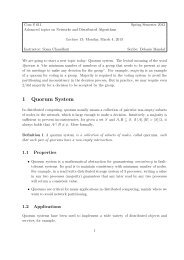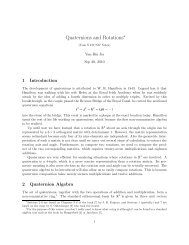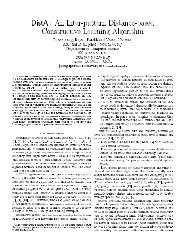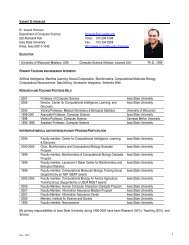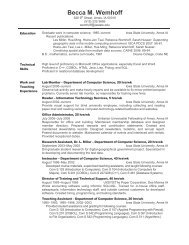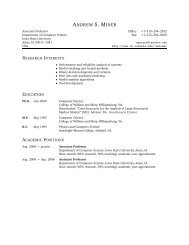learning classifiers from only positive and unlabeled data: theory ...
learning classifiers from only positive and unlabeled data: theory ...
learning classifiers from only positive and unlabeled data: theory ...
Create successful ePaper yourself
Turn your PDF publications into a flip-book with our unique Google optimized e-Paper software.
LEARNING CLASSIFIERS FROM ONLY<br />
POSITIVE AND UNLABELED DATA:<br />
THEORY AND APPLICATIONS<br />
Yetian Chen 10-27-2010<br />
1
2<br />
References<br />
C. Elkan <strong>and</strong> K. Noto. Learning Classifiers <strong>from</strong> Only Positive <strong>and</strong><br />
Unlabeled Data. In Proceedings of the Fourteenth International Conference<br />
on Knowledge Discovery <strong>and</strong> Data Mining (KDD-2008).<br />
Bing Liu, Wee Sun Lee, Philip S Yu <strong>and</strong> Xiaoli Li. Partially Supervised<br />
Classification of Text Documents. Proceedings of the Nineteenth International<br />
Conference on Machine Learning (ICML-2002), 8-12, July 2002, Sydney,<br />
Australia.<br />
Xiaoli Li, Bing Liu. Learning to classify text using <strong>positive</strong> <strong>and</strong> <strong>unlabeled</strong><br />
<strong>data</strong>. Proceedings of Eighteenth International Joint Conference on Artificial<br />
Intelligence (IJCAI-03), Aug 9-15, 2003, Acapulco, Mexico.<br />
Bing Liu, Yang Dai, Xiaoli Li, Wee Sun Lee, Philip Yu. Building Text Classifiers<br />
Using Positive <strong>and</strong> Unlabeled Examples. Proceedings of the Third IEEE<br />
International Conference on Data Mining (ICDM-03), Melbourne, Florida,<br />
November 19-22, 2003.<br />
Xiaoli Li, Bing Liu <strong>and</strong> See-Kiong Ng. Negative Training Data can be<br />
Harmful to Text Classification". To appear in Proceedings of Conference on<br />
Empirical Methods in Natural Language Processing (EMNLP-10). Oct. 9-11,<br />
2010, MIT, Massachusetts, USA.
3<br />
Outline<br />
Statement of the Problem<br />
Theory: Why it is learnable <strong>and</strong> How to learn<br />
Heuristic Solutions <strong>and</strong> Applications in Text Mining<br />
Two-Step Strategy<br />
Negative Training Data Can be Harmful to Text<br />
Classification<br />
Conclusions
4<br />
Classic Supervised Learning<br />
Given a set of labeled training examples of n classes,<br />
the system uses this set to build a classifier.<br />
The classifier is then used to classify new <strong>data</strong> into the<br />
n classes.<br />
Although this traditional model is very useful, in<br />
practice one also encounters another (related)<br />
problem.
5<br />
Learning <strong>from</strong> Positive & Unlabeled <strong>data</strong><br />
(PU-<strong>learning</strong>)<br />
Positive examples: One has a set of examples of a class<br />
P, <strong>and</strong><br />
Unlabeled set: also has a set U of <strong>unlabeled</strong> (or mixed)<br />
examples with instances <strong>from</strong> P <strong>and</strong> also not <strong>from</strong> P<br />
(negative examples).<br />
Build a classifier: Build a classifier to classify the<br />
examples in U <strong>and</strong>/or future (test) <strong>data</strong>.<br />
Key feature of the problem: no labeled negative<br />
training <strong>data</strong>.<br />
We call this problem, PU-<strong>learning</strong>.
6<br />
Applications of the problem<br />
With the growing volume of online texts available<br />
through the Web <strong>and</strong> digital libraries, one often wants to<br />
find those documents that are related to one's work or<br />
one's interest.<br />
For example, given a ICML proceedings,<br />
find all machine <strong>learning</strong> papers <strong>from</strong> AAAI, IJCAI, KDD<br />
No labeling of negative examples <strong>from</strong> each of these<br />
collections.<br />
Similarly, given one's bookmarks (<strong>positive</strong> documents),<br />
identify those documents that are of interest to him/her<br />
<strong>from</strong> Web sources.
7<br />
Direct Marketing<br />
Company has <strong>data</strong>base with details of its customer –<br />
<strong>positive</strong> examples, but no information on those who<br />
are not their customers, i.e., no negative examples.<br />
Want to find people who are similar to their customers<br />
for marketing<br />
Buy a <strong>data</strong>base consisting of details of people, some<br />
of whom may be potential customers – <strong>unlabeled</strong><br />
examples.
8<br />
Are Unlabeled Examples Helpful?<br />
+ u +<br />
u<br />
+<br />
+ u<br />
+ + +<br />
u<br />
u<br />
u<br />
u<br />
u<br />
u<br />
x 1 < 0<br />
u<br />
+<br />
u<br />
+<br />
x 2 > 0<br />
Function known to be either<br />
x 1 < 0 or x 2 > 0<br />
Which one is it?<br />
“Not learnable” with <strong>only</strong> <strong>positive</strong><br />
examples. However, addition of<br />
<strong>unlabeled</strong> examples makes it<br />
learnable.
9<br />
Related Works<br />
Denis (1998) shows that function classes learnable in the statistical query<br />
model is learnable <strong>from</strong> <strong>positive</strong> <strong>and</strong> <strong>unlabeled</strong> examples.<br />
Muggleton (2001) shows that <strong>learning</strong> <strong>from</strong> <strong>positive</strong> examples is<br />
possible if the distribution of inputs is known.<br />
Liu et. al. (2002) gives sample complexity bounds <strong>and</strong> also an algorithm<br />
based on a Spy technique <strong>and</strong> EM.<br />
Yu et. al. (2002, 2003) gives an algorithm that runs SVM iteratively.<br />
Denis et al (2002) gives a Naïve Bayesian method.<br />
Li <strong>and</strong> Liu (2003) gives a Rocchio <strong>and</strong> SVM based method.<br />
Lee <strong>and</strong> Liu (2003) presents a weighted logistic regression technique.<br />
Liu et al (2003) presents a biased-SVM technique.<br />
Elkan et al (2008) show that a classifier trained on <strong>positive</strong> <strong>and</strong><br />
<strong>unlabeled</strong> <strong>data</strong> predicts probabilities that differ by <strong>only</strong> a constant<br />
factor <strong>from</strong> the true conditional probabilities of being <strong>positive</strong>.<br />
Li et al (2010) show that the negative <strong>data</strong> is not needed <strong>and</strong> my even<br />
be harmful for the task when the training <strong>and</strong> test <strong>data</strong> are not<br />
identically distributed.
10<br />
Outline<br />
Statement of the Problem<br />
Theory: Why it is learnable <strong>and</strong> How to learn<br />
Heuristic Solutions <strong>and</strong> Applications in Text Mining<br />
Two-Step Strategy<br />
Negative Training Data Can be Harmful to Text<br />
Classification<br />
Conclusions
11<br />
Theory: Define the Problem<br />
Let x be an example <strong>and</strong> let y{0, 1} be a binary<br />
label. Let s = 1 if the example x is labeled, <strong>and</strong> let<br />
s = 0 if x is <strong>unlabeled</strong>. Only <strong>positive</strong> examples are<br />
labeled, so y = 1 is certain when s = 1, but when s<br />
= 0, then either y = 1 or y = 0 may be true. x, y<br />
<strong>and</strong> s are viewed as r<strong>and</strong>om variables. There is a<br />
fixed unknown distribution p(x, y, s) over .<br />
Fact: p(s=1|x, y=0) = 0<br />
“Selected completely at r<strong>and</strong>om” assumption:<br />
p(s=1|x, y=1) = p(s=1|y=1)<br />
The goal is to learn a function such that<br />
f(x)= p(y=1|x) as closely as possible<br />
Elkan et al (KDD-2008)
12<br />
Theory: Why it is learnable?<br />
We can Learn a nontraditional classifier with a<br />
training set consists of two subsets, “labeled” (s=1)<br />
<strong>and</strong> “<strong>unlabeled</strong>” (s=0): g(x) = p(s=1|x) .<br />
Goal: learn f(x)= p(y=1|x)<br />
Lemma: If the “selected completely at r<strong>and</strong>om”<br />
assumption holds. Then<br />
p(y=1|x) = p(s=1|x)/c<br />
where c = p(s=1|y=1)<br />
Proof: P(s=1|x) = p(y=1<strong>and</strong> s=1|x)<br />
= p(y=1|x)p(s=1|y=1, x)<br />
= p(y=1|x)p(s=1|y=1)<br />
Elkan et al (KDD-2008)
13<br />
Estimators of c = p(s=1|y=1)<br />
c = p(s = 1|y = 1) can be estimated using a trained classifier g <strong>and</strong><br />
a validation set of examples. Let V be such a validation set that is<br />
drawn <strong>from</strong> the overall distribution p(x, y, s). Let P be the subset of<br />
examples in V that are labeled (<strong>and</strong> hence <strong>positive</strong>).<br />
1<br />
e1 g( x)<br />
xP n<br />
A second estimator c is<br />
e2 g( x) g( x)<br />
<br />
xPxV A third estimator c is (because g( x) c for all x)<br />
e max g( x)<br />
3<br />
xV <br />
The first estimator is the best one to use in practice because of lower variance
14<br />
An Illustration<br />
Elkan et al (KDD-2008)
15<br />
Application to Real-world Data<br />
TCDB <strong>data</strong>base: 2453 <strong>positive</strong>, 4906 <strong>unlabeled</strong> ( about 10% <strong>positive</strong>)<br />
Elkan et al (KDD-2008)
16<br />
Theoretical foundations (Liu et al 2002)<br />
(X, Y): X - input vector, Y {1, -1} - class label.<br />
f : classification function<br />
We rewrite the probability of error<br />
Pr[f(X) Y] = Pr[f(X) = 1 <strong>and</strong> Y = -1] + (1)<br />
Pr[f(X) = -1 <strong>and</strong> Y = 1]<br />
We have Pr[f(X) = 1 <strong>and</strong> Y = -1]<br />
= Pr[f(X) = 1] – Pr[f(X) = 1 <strong>and</strong> Y = 1]<br />
= Pr[f(X) = 1] – (Pr[Y = 1] – Pr[f(X) = -1 <strong>and</strong> Y = 1]).<br />
Plug this into (1), we obtain<br />
Pr[f(X) Y] = Pr[f(X) = 1] – Pr[Y = 1] (2)<br />
+ 2Pr[f(X) = -1|Y = 1]Pr[Y = 1]
17<br />
Theoretical foundations (cont)<br />
Pr[f(X) Y] = Pr[f(X) = 1] – Pr[Y = 1] (2)<br />
+ 2Pr[f(X) = -1|Y = 1] Pr[Y = 1]<br />
Note that Pr[Y = 1] is constant.<br />
If we can hold Pr[f(X) = -1|Y = 1] small, then <strong>learning</strong> is<br />
approximately the same as minimizing Pr[f(X) = 1].<br />
Holding Pr[f(X) = -1|Y = 1] small while minimizing Pr[f(X) = 1]<br />
is approximately the same as minimizing Pr u[f(X) = 1] while<br />
holding Pr P[f(X) = 1] ≥ r (where r is recall) if the set of <strong>positive</strong><br />
examples P <strong>and</strong> the set of <strong>unlabeled</strong> examples U are large<br />
enough.<br />
Theorem 1 <strong>and</strong> Theorem 2 in [Liu et al 2002] state these<br />
formally in the noiseless case <strong>and</strong> in the noisy case.
18<br />
Put it simply<br />
A constrained optimization problem.<br />
A reasonably good generalization (<strong>learning</strong>) result<br />
can be achieved<br />
If the algorithm tries to minimize the number of<br />
<strong>unlabeled</strong> examples labeled as <strong>positive</strong><br />
subject to the constraint that the fraction of errors on the<br />
<strong>positive</strong> examples is no more than 1-r.
18 19<br />
An Application: Text Classification<br />
Naïve Bayesian Text Classification<br />
Given a set of training documents D, each document di∈D is an<br />
ordered list of words. We use w di,k to denote the word in position k of<br />
d i, where each word is <strong>from</strong> the vocabulary V = {w 1, … , w |V|}. We<br />
also have a set of classes C = {c 1, c 2} representing <strong>positive</strong> <strong>and</strong><br />
negative classes. For classification, we compute the posterior<br />
probability Pr(c j|d i). Based on the Bayes rule <strong>and</strong> multinomial model,<br />
we have<br />
Then we have the<br />
NB classifier:
20<br />
Existing 2-step strategy<br />
Step 1: Identifying a set of reliable negative documents<br />
<strong>from</strong> the <strong>unlabeled</strong> set.<br />
S-EM [Liu et al, 2002] uses a Spy technique,<br />
PEBL [Yu et al, 2002] uses a 1-DNF technique<br />
Roc-SVM [Li & Liu, 2003] uses the Rocchio algorithm.<br />
Step 2: Building a sequence of <strong>classifiers</strong> by iteratively<br />
applying a classification algorithm <strong>and</strong> then selecting a<br />
good classifier.<br />
S-EM uses the Expectation Maximization (EM) algorithm, with<br />
an error based classifier selection mechanism<br />
PEBL uses SVM, <strong>and</strong> gives the classifier at convergence. I.e., no<br />
classifier selection.<br />
Roc-SVM uses SVM with a heuristic method for selecting the<br />
final classifier.
21<br />
U<br />
P<br />
Step 1 Step 2<br />
<strong>positive</strong> negative<br />
<strong>positive</strong><br />
Reliable<br />
Negative<br />
(RN)<br />
Q<br />
=U - RN<br />
Using P, RN <strong>and</strong> Q to build the<br />
final classifier iteratively<br />
or<br />
Using <strong>only</strong> P <strong>and</strong> RN to build<br />
a classifier
22<br />
Step 1: The Spy technique<br />
Sample a certain % of <strong>positive</strong> examples <strong>and</strong> put<br />
them into <strong>unlabeled</strong> set to act as “spies”.<br />
Run a classification algorithm assuming all <strong>unlabeled</strong><br />
examples are negative,<br />
we will know the behavior of those actual <strong>positive</strong> examples<br />
in the <strong>unlabeled</strong> set through the “spies”.<br />
We can then extract reliable negative examples <strong>from</strong><br />
the <strong>unlabeled</strong> set more accurately.
23<br />
Step 1: The Spy technique
24<br />
Step 1: The Spy technique
25<br />
Step 1: Other methods<br />
1-DNF method:<br />
Find the set of words W that occur in the <strong>positive</strong> documents<br />
more frequently than in the <strong>unlabeled</strong> set.<br />
Extract those documents <strong>from</strong> <strong>unlabeled</strong> set that do not<br />
contain any word in W. These documents form the reliable<br />
negative documents.<br />
Rocchio method <strong>from</strong> information retrieval<br />
Naïve Bayesian method.
Step 2: Running EM or SVM iteratively<br />
26<br />
(1) Running a classification algorithm iteratively<br />
Run EM using P, RN <strong>and</strong> Q until it converges, or<br />
Run SVM iteratively using P, RN <strong>and</strong> Q until this no document<br />
<strong>from</strong> Q can be classified as negative. RN <strong>and</strong> Q are updated<br />
in each iteration, or<br />
…<br />
(2) Classifier selection .
Step 2: EM<br />
27
28<br />
Do they follow the <strong>theory</strong>?<br />
Yes, heuristic methods because<br />
Step 1 tries to find some initial reliable negative examples<br />
<strong>from</strong> the <strong>unlabeled</strong> set.<br />
Step 2 tried to identify more <strong>and</strong> more negative examples<br />
iteratively.<br />
The two steps together form an iterative strategy of<br />
increasing the number of <strong>unlabeled</strong> examples that are<br />
classified as negative while maintaining the <strong>positive</strong><br />
examples correctly classified.
29<br />
Can SVM be applied directly?<br />
Can we use SVM to directly deal with the problem of<br />
<strong>learning</strong> with <strong>positive</strong> <strong>and</strong> <strong>unlabeled</strong> examples, without<br />
using two steps?<br />
Yes, with a little re-formulation.<br />
The <strong>theory</strong> says that if the sample size is large enough,<br />
minimizing the number of <strong>unlabeled</strong> examples classified<br />
as <strong>positive</strong> while constraining the <strong>positive</strong> examples to<br />
be correctly classified will give a good classifier.
30<br />
Support Vector Machines<br />
Support vector machines (SVM) are linear functions of<br />
the form f(x) = w T x + b, where w is the weight vector<br />
<strong>and</strong> x is the input vector.<br />
Let the set of training examples be {(x 1, y 1), (x 2, y 2),<br />
…, (x n, y n)}, where x i is an input vector <strong>and</strong> y i is its class<br />
label, y i {1, -1}.<br />
To find the linear function:<br />
Minimize:<br />
Subject to:<br />
1<br />
2<br />
w w<br />
T<br />
T<br />
yi ( w<br />
xi<br />
b)<br />
<br />
1,<br />
i<br />
1,<br />
2, ..., n
31<br />
Soft margin SVM<br />
To deal with cases where there may be no separating<br />
hyperplane due to noisy labels of both <strong>positive</strong> <strong>and</strong><br />
negative training examples, the soft margin SVM is<br />
proposed:<br />
Minimize:<br />
Subject to:<br />
1<br />
2<br />
w<br />
T<br />
w<br />
<br />
n<br />
C i1<br />
where C 0 is a parameter that controls the amount of<br />
training errors allowed.<br />
<br />
T<br />
yi ( w<br />
xi<br />
b)<br />
1<br />
i<br />
,<br />
i<br />
i<br />
1,<br />
2, ..., n
Biased SVM (noiseless case) (Liu et al 2003)<br />
32<br />
Assume that the first k-1 examples are <strong>positive</strong> examples<br />
(labeled 1), while the rest are <strong>unlabeled</strong> examples,<br />
which we label negative (-1).<br />
Minimize:<br />
Subject to:<br />
1<br />
2<br />
w<br />
w w<br />
T<br />
T<br />
x<br />
i<br />
-1(<br />
w<br />
<br />
<br />
ik<br />
i 0, i = k, k+1…, n<br />
n<br />
C <br />
i<br />
b 1,<br />
i 1,<br />
2, ..., k 1<br />
T<br />
x<br />
i<br />
,<br />
b) 1<br />
i<br />
i<br />
k,<br />
k<br />
<br />
1,<br />
...,<br />
n
33<br />
Biased SVM (noisy case)<br />
If we also allow <strong>positive</strong> set to have some noisy negative<br />
examples, then we have:<br />
Minimize:<br />
Subject to:<br />
1 T<br />
w<br />
w<br />
2<br />
-1(<br />
w<br />
T<br />
x<br />
b) 1<br />
i<br />
i 0, i = 1, 2, …, n.<br />
This turns out to be the same as the asymmetric cost SVM<br />
for dealing with unbalanced <strong>data</strong>. Of course, we have a<br />
different motivation.<br />
i<br />
<br />
k1<br />
<br />
i1<br />
,<br />
<br />
C C <br />
i<br />
n<br />
<br />
ik<br />
i<br />
i<br />
<br />
1,<br />
2...,<br />
n
34<br />
Estimating performance<br />
We need to estimate the performance in order to<br />
select the parameters.<br />
Since <strong>learning</strong> <strong>from</strong> <strong>positive</strong> <strong>and</strong> negative examples<br />
often arise in retrieval situations, we use F score as the<br />
classification performance measure F = 2pr / (p+r) (p:<br />
precision, r: recall).<br />
To get a high F score, both precision <strong>and</strong> recall have to<br />
be high.
35<br />
Empirical Evaluation<br />
Two-step strategy: Liu et al implemented a benchmark system,<br />
called LPU, which is available at<br />
http://www.cs.uic.edu/~liub/LPU/LPU-download.html<br />
Step 1:<br />
Spy<br />
1-DNF<br />
Rocchio<br />
Naïve Bayesian (NB)<br />
Step 2:<br />
EM with classifier selection<br />
SVM-one: Run SVM once.<br />
SVM-I: Run SVM iteratively <strong>and</strong> give converged classifier.<br />
SVM-IS: Run SVM iteratively with classifier selection<br />
Biased-SVM (we used SVMlight package)
36<br />
Spy vs NB (use U as Negative Example)
Table 1: Average F scores on Reuters collection<br />
1 2 3 4 5 6 7 8 9 10 11 12 13 14 15 16 17<br />
Step1 1-DNF 1-DNF 1-DNF Spy Spy Spy Rocchio Rocchio Rocchio NB NB NB NB<br />
Step2 EM SVM PEBL SVM-IS S-EM SVM SVM-I SVM-IS EM SVM SVM-I Roc-SVM EM SVM SVM-I SVM-IS NB<br />
370.1<br />
0.187 0.423 0.001 0.423 0.547 0.329 0.006 0.328 0.644 0.589 0.001 0.589 0.547 0.115 0.006 0.115 0.514<br />
0.2 0.177 0.242 0.071 0.242 0.674 0.507 0.047 0.507 0.631 0.737 0.124 0.737 0.693 0.428 0.077 0.428 0.681<br />
0.3 0.182 0.269 0.250 0.268 0.659 0.733 0.235 0.733 0.623 0.780 0.242 0.780 0.695 0.664 0.235 0.664 0.699<br />
0.4 0.178 0.190 0.582 0.228 0.661 0.782 0.549 0.780 0.617 0.805 0.561 0.784 0.693 0.784 0.557 0.782 0.708<br />
0.5 0.179 0.196 0.742 0.358 0.673 0.807 0.715 0.799 0.614 0.790 0.737 0.799 0.685 0.797 0.721 0.789 0.707<br />
0.6 0.180 0.211 0.810 0.573 0.669 0.833 0.804 0.820 0.597 0.793 0.813 0.811 0.670 0.832 0.808 0.824 0.694<br />
0.7 0.175 0.179 0.824 0.425 0.667 0.843 0.821 0.842 0.585 0.793 0.823 0.834 0.664 0.845 0.822 0.843 0.687<br />
0.8 0.175 0.178 0.868 0.650 0.649 0.861 0.865 0.858 0.575 0.787 0.867 0.864 0.651 0.859 0.865 0.858 0.677<br />
0.9 0.172 0.190 0.860 0.716 0.658 0.859 0.859 0.853 0.580 0.776 0.861 0.861 0.651 0.846 0.858 0.845 0.674<br />
Table 2: Average F scores on 20Newsgroup collection<br />
1 2 3 4 5 6 7 8 9 10 11 12 13 14 15 16 17<br />
Step1 1-DNF 1-DNF 1-DNF Spy Spy Spy Rocchio Rocchio Rocchio NB NB NB NB<br />
Step2 EM SVM PEBL SVM-IS S-EM SVM SVM-I SVM-IS EM SVM SVM-I Roc-SVM<br />
EM SVM SVM-I SVM-IS NB<br />
0.1 0.145 0.545 0.039 0.545 0.460 0.097 0.003 0.097 0.557 0.295 0.003 0.295 0.368 0.020 0.003 0.020 0.333<br />
0.2 0.125 0.371 0.074 0.371 0.640 0.408 0.014 0.408 0.670 0.546 0.014 0.546 0.649 0.232 0.013 0.232 0.611<br />
0.3 0.123 0.288 0.201 0.288 0.665 0.625 0.154 0.625 0.673 0.644 0.121 0.644 0.689 0.469 0.120 0.469 0.674<br />
0.4 0.122 0.260 0.342 0.258 0.683 0.684 0.354 0.684 0.671 0.690 0.385 0.682 0.705 0.610 0.354 0.603 0.704<br />
0.5 0.121 0.248 0.563 0.306 0.685 0.715 0.560 0.707 0.663 0.716 0.565 0.708 0.702 0.680 0.554 0.672 0.707<br />
0.6 0.123 0.209 0.646 0.419 0.689 0.758 0.674 0.746 0.663 0.747 0.683 0.738 0.701 0.737 0.670 0.724 0.715<br />
0.7 0.119 0.196 0.715 0.563 0.681 0.774 0.731 0.757 0.660 0.754 0.731 0.746 0.699 0.763 0.728 0.749 0.717<br />
0.8 0.124 0.189 0.689 0.508 0.680 0.789 0.760 0.783 0.654 0.761 0.763 0.766 0.688 0.780 0.758 0.774 0.707<br />
0.9 0.123 0.177 0.716 0.577 0.684 0.807 0.797 0.798 0.654 0.775 0.798 0.790 0.691 0.806 0.797 0.798 0.714
38<br />
Results of Biased SVM<br />
Table 3: Average F scores on the two collections<br />
Reuters<br />
20Newsgroup<br />
<br />
Average F score of<br />
Biased-SVM<br />
Previous best F<br />
score<br />
0.3 0.785 0.78<br />
0.7 0.856 0.845<br />
0.3 0.742 0.689<br />
0.7 0.805 0.774
39<br />
Negative Training Data can be<br />
Harmful to Text Classification<br />
For traditional supervised <strong>learning</strong> algorithm, fundamental<br />
assumption is that the training <strong>and</strong> test <strong>data</strong> are identically<br />
distributed. However, this assumption may not hold in<br />
practice.<br />
A special problem: <strong>positive</strong> training <strong>and</strong> test samples have<br />
identical distributions, but the negative training <strong>and</strong> test<br />
samples may have different distributions.<br />
A classifier trained on ACL <strong>and</strong> EMNLP proceedings to find<br />
sentimental analysis papers may not appropriate for identifying<br />
sentimental analysis papers <strong>from</strong> the WWW, KDD <strong>and</strong> SIGIR<br />
A spam classification system built using the training <strong>data</strong> of spam<br />
<strong>and</strong> non-spam <strong>from</strong> a university may not perform well in a<br />
company<br />
It is impractical to label all the negative <strong>data</strong> in each<br />
domain individually.<br />
Li et al (2010)
40<br />
Proposed CR-SVM Algorithm<br />
Step 1 Step 2<br />
Step 1: Extracting reliable negatives RN <strong>from</strong> U<br />
using Cosine <strong>and</strong> Rocchio<br />
Step 2: Learning by running SVM iteratively<br />
(SVM doesn’t make any distributional assumption)<br />
Li et al (2010)
41<br />
Negative Training Data can be<br />
Harmful to Text Classification<br />
Training:<br />
Positive<br />
Unlabeled:<br />
<strong>positive</strong> + one<br />
class negative<br />
Testing:<br />
Unlabeled: one<br />
class negative +<br />
other negative<br />
documents<br />
Li et al (2010)
42<br />
Distributions of the negative training<br />
<strong>and</strong> test samples are identical<br />
PU <strong>learning</strong> is shown to perform equally well as supervised <strong>learning</strong>,<br />
which means the negative training <strong>data</strong> is not needed.<br />
Li et al (2010)
43<br />
Some discussions<br />
All the current two-step methods are applicable <strong>only</strong> to<br />
text <strong>data</strong>.<br />
Biased-SVM (Liu et al 2003) <strong>and</strong> Weighted Logistic<br />
Regression (Lee & Liu 2003) are applicable to any<br />
types of <strong>data</strong>.
44<br />
Conclusions<br />
Gave an overview of the <strong>theory</strong> on <strong>learning</strong> with <strong>positive</strong> <strong>and</strong><br />
<strong>unlabeled</strong> examples.<br />
Described the existing two-step strategy for <strong>learning</strong>.<br />
Presented an more principled approach to solve the problem<br />
based on a biased SVM formulation.<br />
Show that when the distributions of the negative training <strong>and</strong> test<br />
samples are different, PU <strong>learning</strong> is much more accurate than<br />
traditional supervised <strong>learning</strong> <strong>from</strong> the <strong>positive</strong> <strong>and</strong> negative<br />
training samples. The negative training <strong>data</strong> actually harms the<br />
classification in this case.<br />
Show that PU <strong>learning</strong> performs equally well as supervised<br />
<strong>learning</strong> when the training <strong>and</strong> test <strong>data</strong> are identically<br />
distributed. The negative training <strong>data</strong> is not needed.



